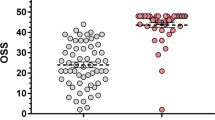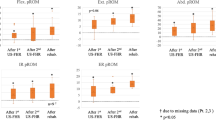Abstract
Objective
To observe the clinical efficacy of filiform fire-needling plus continuous passive motion (CPM) therapy for frozen shoulder.
Methods
A total of 72 patients were randomized into an observation group and a control group by the random number table method, with 36 cases in each group. Patients in the control group received celecoxib capsule plus CPM, while those in the observation group received filiform fire-needling plus CPM. The whole course of treatment lasted for 2 weeks in both groups. The visual analog scale (VAS), Constant-Murley score (CMS) and range of motion of shoulder joint were measured for therapeutic efficacy evaluation.
Results
The total effective rate was 91.7% in the observation group, higher than 72.2% in the control group, and the between-group comparison showed statistical significance (P<0.05). After treatment, the VAS scores in the two groups dropped significantly, the CMS as well as the range of motion including abduction, forward flexion and extension were all increased significantly, and the intra-group comparisons showed statistical significance (all P<0.05). The between-group comparisons showed the improvements in these items in the observation group were more significant than those in the control group (all P<0.05).
Conclusion
Filiform fire-needling plus CPM can produce more significant efficacy than celecoxib capsule plus CPM for frozen shoulder; it can alleviate pain, improve shoulder function and restore joint range of motion in such patients.
摘要
目的
观察毫火针加持续被动运动(CPM)治疗肩凝症的临床疗效.
方法
将72 例患者按随机数字表法分 为观察组和对照组, 每组36 例. 对照组予塞来昔布胶囊加CPM治疗, 观察组予毫火针加CPM治疗. 两组疗程均为 2 周. 比较两组患者治疗前后视觉模拟量表(VAS)评分、Constant-Murley评分(CMS)及肩关节活动度, 并评价临床疗 效.
结果
观察组的总有效率为91.7%, 高于对照组的72.2%, 两组总有效率差异有统计学意义 (P<0.05). 治疗 后两组患者VAS评分均较本组治疗前下降, CMS评分及外展、前屈、后伸活动度均较本组治疗前增加, 组内差异均 有统计学意义(均P<0.05). 组间治疗后比较, 观察组上述指标的改善情况均优于对照组(均P<0.05).
结论
毫火 针加CPM治疗肩凝症疗效优于塞来昔布胶囊加CPM治疗, 能迅速缓解疼痛, 改善关节功能, 恢复关节活动度.
Similar content being viewed by others
References
Chan HBY, Pua PY, How CH. Physical therapy in the management of frozen shoulder. Singapore Med J, 2017, 58(12): 685–689.
Uppal HS, Evans JP, Smith C. Frozen shoulder: a systematic review of therapeutic options. World J Orthop, 2015, 6(2): 263–268.
Xu Y, Zhang C, Liu ZL, Jiao WG. Progress on treatments of traditional Chinese medicine for frozen shoulder. Shijie Zhongxiyi Jiehe Zazhi, 2016, 11(11): 1619–1623.
Qian H, Zhao JN, Bao NR. Treatment progress of frozen shoulder. Jing Yaotong Zazhi, 2017, 38(1): 69–72.
Wang WY, Huang SX. Huang Shi-xi’s clinical experience in treating Bi-impediment syndrome by mainly using filiform-fire needle. Zhonghua Zhongyiyao Zazhi, 2018, 33(8): 3448–3450.
Yao WF, Li SY. Research progress on traditional Chinese medicine fire-needle therapy. Zhongguo Zhongxiyi Jiehe Pifuxingbingxue Zazhi, 2016, 15(4): 258–260.
China Association of Chinese Medicine. Periarthritis of shoulder (ZYYXH/T378-2012). Fengshibing Yu Guanjieyan, 2013, 2(2): 73–75.
Yang R, Zhu XQ, Xiao L, Wang WW, Feng L. Consistency of visual analog scale and quick inventory of depressive symptomatology self-report. Zhongguo Yikan, 2018, 53(8): 918–921.
Wang Q, Jia J. Modification and clinical assessment of the evaluation scale for periarthritis of shoulder. Zhongguo Kangfu Yixue Zazhi, 2018, 33(4): 1424–1428.
Ministry of Health of the People’s Republic of China. Guiding Principles for Clinical Study of New Chinese Medicines (3rd Volume). Beijing: Ministry of Health of the People’s Republic of China, 1997: 141–142.
Chen WX, Bao NR, Zhao JN. Research progresses on the cause of primary frozen shoulder. Jiangsu Yiyao, 2017, 43(4): 271–274.
Sun WB, Zhang C, Wang J. Advances in modern medicine research about pathogenesis of frozen shoulder. Zhongguo Yiyao Daobao, 2017, 14(4): 43–46.
Wang Y, Dang XQ, Wang KZ, Wang JH. Molecule mechanism and research progress on primary frozen shoulder. Zhonghua Guanjie Waike Zazhi, 2014, 8(1): 113–115.
Zhou JY, Li M, Zhu LL, Yue YQ, Luo L. Mechanism of fire needling therapy and clinical applications. Liaoning Zhongyiyao Daxue Xuebao, 2016, 18(7): 86–88.
Wang QY. Examples of fire-needle therapy in dermatology department. Guangming Zhongyi, 2016, 31(12): 3404–3405.
Wu J, Shen RR. Laboratory study of fire-needle in the treatment of chronic soft tissue damage. Zhongguo Zhen Jiu, 2002, 22(1): 31–33.
Lu WW, Wu J, Shao RS. Experimental study of fire acupuncture on parenchyma with chronic injury. Xiandai Zhongxiyi Jiehe Zazhi, 2003, 12(21): 2278–2279.
Ouyang LX, Fang XK, Huang HF. Therapeutic observation on fire-needle therapy for cervical spondylosis of nerve root type. Shanghai Zhenjiu Zazhi, 2013, 32(8): 662–663.
ELH, Wen YH. Therapeutic evaluation on continuous passive movement for the treatment of periarthritis of shoulder. Zhongguo Shiyong Yiyao, 2016, 11(23): 95–96.
Liu EJ, Wang JY, Yi Z. Clinical study on intradermal needle at tender points plus continuous passive movement in treating periarthritis of shoulder. Shanghai Zhenjiu Zazhi, 2018, 37(12): 1424–1427.
Huang LH, Bai YH. Therapeutic evaluation on continuous passive movement plus ultrashort wave and dynamic electric interference for the treatment of periarthritis of shoulder. Zhongguo Kangfu Yixue Zazhi, 2015, 30(1): 55–56.
Acknowledgments
This work was supported by Funding Project of National Administration of Traditional Chinese Medicine (国家中医 药管理局资助项目, No. LP0118041).
Author information
Authors and Affiliations
Corresponding author
Additional information
Conflict of Interest
The authors declare that there is no conflict of interest.
Statement of Informed Consent
Informed consent was obtained from all individual participants.
Rights and permissions
About this article
Cite this article
Cao, Y., Chen, C., Zhou, Wj. et al. Clinical observation on filiform fire-needling plus continuous passive motion therapy for frozen shoulder. J. Acupunct. Tuina. Sci. 18, 281–285 (2020). https://doi.org/10.1007/s11726-020-1189-5
Received:
Accepted:
Published:
Issue Date:
DOI: https://doi.org/10.1007/s11726-020-1189-5
Keywords
- Acupuncture Therapy
- Fire-needle Therapy
- Motion Therapy, Continuous Passive
- Frozen Shoulder
- Shoulder Pain
- Visual Analog Scale
- Constant-Murley Score
- Range of Motion, Articular




